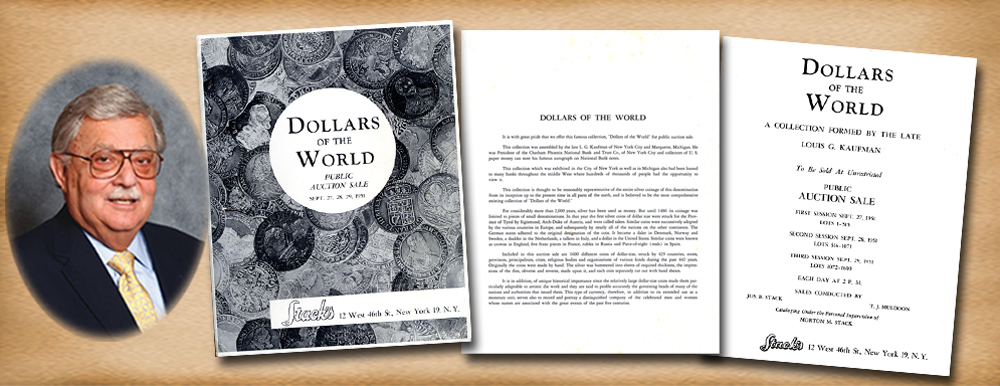
In that year we were contacted by a bank in Michigan who asked us to sell a collection that they had on display. It was called “Dollars of the World” and contained some 1,600 different dollar size (crown size to our collecting friends) coins. Covering issues from 429 countries, the accumulation included from the earliest issue dated 1486 to when the collector stopped.
The collection was formed by L.G. Kaufman, a banker of great renown at the time, and was exhibited first in New York City and Marquette, Michigan. He was president of the Chatham Phoenix National Bank and Trust Company, and collectors of U.S. currency can note his signature on National Bank Notes. The “Dollars of the World” collection was exhibited all over the United States as an educational display, and hundreds of thousands of people had the opportunity to see it before it was consigned by the Marquette Bank for auction by Stack’s.
The exhibit showed examples of the earliest dated dollar-size coin, issued by Sigismund in Tyrol, and called the “taler.” This became a standard size and weight for coins to be used for payment for debts and services in countries worldwide. Many countries and states issued coins of this size for easy trade purposes and it was often called by similar, yet different names. For example, in Denmark, Norway and Sweden it became “daler.” In Germany it was “taler” or “thaler,” in Italy it was “tallero,” and in the United States it was “dollar.” In England it was known as a “crown,” in France “five francs,” in Russia a “ruble” and in Spain an “eight reales” or “piece of eight.” All of these and more were included in the “Dollars of the World” display.
The collection was shown on large trays, with wooden dividers, each opening measuring about two inches square, with some 24 openings on each tray. Each coin was numbered on a green card set below the coins, and six trays were inserted into a leather box, which was fitted into a special shipping trunk so it could be transported easily. Each coin was likewise described in a booklet that helped those who viewed the exhibit know just what they were seeing and admiring. The booklet descriptions covered the 429 countries, states, provinces, principalities, cities, religious bodies and organizations of various kinds that struck these coins over 442 years.
Originally, these large silver-dollar size coins were made by hand. The silver was hammered into sheets of the required thickness, impressions of the dies, both obverse and reverse, were made on it, and each coin was cut from the strip with iron sheers. Later on, the planchets were cut first and a screw press was used to stamp the coins. The coins were then adjusted at the mint to take care of any surplus weight, and then they were ready for circulation. The Industrial Revolution brought more advanced presses that used greater weight as well as collars to create better products. The need for currency in trade was so important that the mints of the world obtained the most modern machinery to strike coins.
In addition to their monetary use, these large silver coins lent themselves to artwork that would commemorate the images and happenings of each ruler’s reign, and were also used to record great historical events, great art of the period, and created a permanent record for centuries of issuance.
Mr. Kaufman often accompanied the exhibit to give lectures about the history surrounding the coins. After he passed away, one of his banks in Michigan in 1951 decided that the cost of maintaining the exhibits was too much for them to underwrite, though they knew it did provide an excellent tool for studying finance and history and that many had benefited from seeing it. It was then that Stack’s was selected to offer it for sale at public auction. The sale attracted collectors from all over the United States, many of whom had heard about or seen the exhibit and wanted to own some of the coins from this noteworthy collection.
As Mr. Kaufman desired, the collection served as a learning tool for young and old. Unfortunately, today some museums and libraries have had to sell collections in order to support other educational endeavors. Others have had to downsize their exhibit rooms or keep many numismatic items stored away in vaults, often leaving it to numismatics to be the venue to illustrate the important role of coins in history and art.





